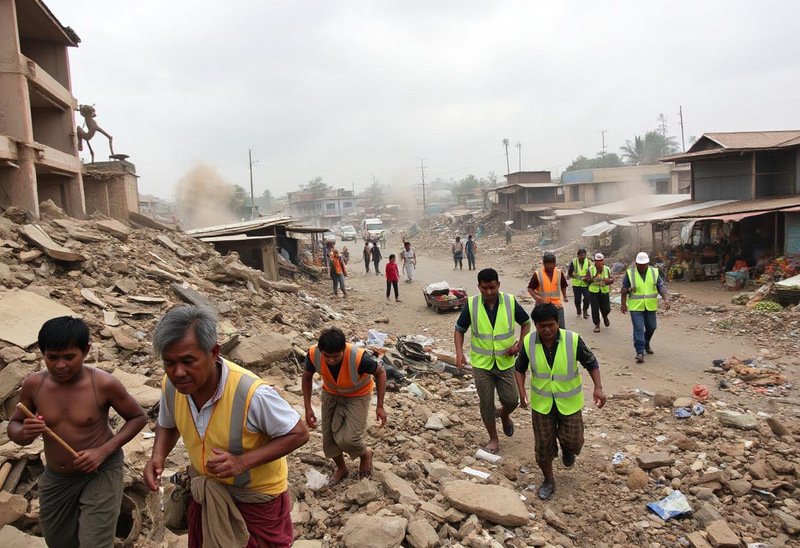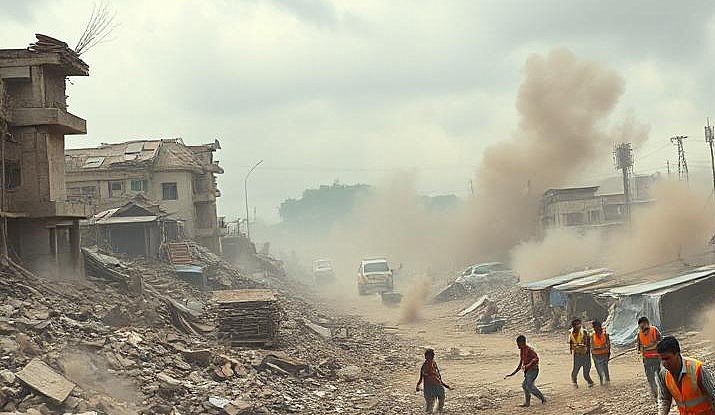Global media Update tech Update & Automobile Life Style & Entertainment

March 28, 2025 – A powerful 7.7-magnitude earthquake struck central Myanmar at approximately 12:50 PM local time, with its epicenter near Mandalay, the country’s second-largest city. The quake has caused significant loss of life and widespread destruction across the region, making it one of the deadliest disasters in Myanmar’s history.
As of March 29, the confirmed death toll has risen to at least 694, with more than 1,670 individuals injured. The earthquake has wreaked havoc on infrastructure, leveling buildings, bridges, and roads across Mandalay and surrounding areas. One of the most tragic incidents occurred when a mosque collapsed during prayers, resulting in multiple fatalities. Authorities warn that the number of casualties could rise as rescue operations continue.
The strong tremors also led to landslides in rural areas, cutting off access to villages and making rescue efforts more challenging. Reports indicate that numerous homes, hospitals, and schools have suffered extensive damage, leaving thousands homeless.


 Amazon: दुनिया का सबसे बड़ा ऑनलाइन शॉपिंग प्लेटफॉर्म, जहां आपको बेहतरीन डील्स और विश्वसनीय प्रोडक्ट्स मिलते
Amazon: दुनिया का सबसे बड़ा ऑनलाइन शॉपिंग प्लेटफॉर्म, जहां आपको बेहतरीन डील्स और विश्वसनीय प्रोडक्ट्स मिलते
The earthquake’s impact was not confined to Myanmar alone. In Bangkok, Thailand—approximately 600 miles from the epicenter—a high-rise building under construction collapsed, causing at least six deaths and injuring dozens of others. Tremors were also felt in parts of eastern India, including Assam and West Bengal, as well as in southwestern China. Though no major damage was reported in these regions, the seismic activity has raised concerns about aftershocks and structural vulnerabilities in neighboring countries.
Emergency response teams and volunteers are working tirelessly to locate survivors trapped under debris. Myanmar’s military leader, Senior General Min Aung Hlaing, has declared a state of emergency, calling for national and international assistance to cope with the scale of the disaster. International organizations, including the United Nations, Red Cross, and World Health Organization, have pledged support, while governments from the United States, the European Union, and India have offered humanitarian aid.
Rescue teams from neighboring countries are expected to arrive in Myanmar within the next 48 hours to provide medical assistance, distribute relief supplies, and support local search and recovery efforts. Temporary shelters have been set up to accommodate displaced individuals, but concerns remain over the availability of clean water, food, and medical resources.

Myanmar was already facing a severe humanitarian crisis due to ongoing political unrest and civil conflict. The earthquake has exacerbated the country’s struggles, creating further instability. The destruction of telecommunication networks and transportation infrastructure has hindered communication and relief efforts, making it difficult for aid organizations to assess the full scale of the crisis.
The United Nations has approved an initial $5 million emergency fund to assist Myanmar in immediate relief efforts. However, humanitarian agencies warn that much more funding will be needed to rebuild affected areas and provide long-term support to victims.
This earthquake is the most powerful to hit Myanmar since 1912, underscoring the region’s vulnerability to seismic activity. The country sits on the active Sagaing fault line, which runs through major cities, including Yangon, Naypyidaw, and Mandalay. Previous earthquakes along this fault have resulted in significant damage, and experts warn that future tremors could pose a continued threat to Myanmar’s urban centers.
Seismologists have urged the Myanmar government to strengthen building regulations and invest in earthquake-resistant infrastructure to mitigate future disasters. The latest catastrophe serves as a stark reminder of the urgent need for improved disaster preparedness in the region.

As rescue and recovery efforts continue, authorities fear that the death toll could rise further. Many survivors remain trapped under collapsed structures, and emergency workers are racing against time to save lives. The full extent of the damage will take weeks to assess, and rebuilding efforts may take years.
The international community remains on high alert, ready to provide further assistance as Myanmar grapples with the aftermath of this catastrophic event. While immediate relief efforts are focused on providing food, shelter, and medical care, the long-term challenge will be restoring normalcy and rebuilding the affected communities.
The people of Myanmar now face the daunting task of recovery, but with global support, there is hope for rebuilding and resilience in the wake of this tragic disaster.
Auto Amazon Links: No products found.